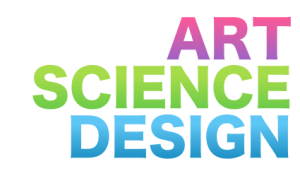What is Design Thinking?
For as many people as you ask, you may get as many different responses. We can only give ours.
- Design Thinking is an intersection of Art, Science, and Design
- Design Thinking is the freedom to consider all sides of a problem, unencumbered by obstacles to find new solutions
That’s as simple as we can make it. We are all very, very good at coming up with obstacles. We’ve been trained to do so our entire lives. We learn to fear risk and missteps in order to protect ourselves physically. Professionally, we learn to fear financial risk, time, budget, resources, and the most heinous of crimes–to fear political backlash for surfacing ideas. But to invent and conceive of new ideas, none of these things matter.
What is The Design Thinking Salon?
The Design Thinking Salon may borrow a term currently used by a thousand agencies to sell design services. However, the truth is that we–every single one of us–are designers by birth.
Design is our path to solving the world’s most complex and largest problems. Design Thinking belongs to engineers, dancers, biologists, gardeners, nurses, chefs, students, garage inventors, educators, architects, pastors and poets.
All of us have something to contribute, and all of us could use a little inspiration now and then. We certainly want to use this space to provide information on methodology, process, templates and training. However, this site was built specifically to tell the stories of those who took apart a problem, turned it, examined it and thoughtfully designed a brand new approach. We hope you’re inspired, because we have a lot of problems to solve.
Here is a secret we wish everyone understood: Constraints change faster than good design ideas.
There will always be constraints, some entirely artificial, some less important that the weight they are given, some that expire quickly, some the almost comically repeated warning from the same person, like a corporate parrot.
Technology changes, resources change – our constraints should never overrule our design imagination.
We must take a step forward into the abyss and be ok with not yet knowing most, or better yet, any of the answers. Because this is what causes us to ask questions. Questions of those who experience the very problem we are trying to solve. It may be users, customers, students, or patients. However, it may also be honeybees, animals, and drought affected plants. The latter of which are all terrible at answering questions. This is why we have many other methods of observation available, and all of them matter.
Design Thinking is looking at a problem from how a service, product, tool, or process is designed in order to improve all, or a portion of it, or to completely redesign a solution to suit the problem.
While reading this, you may have pictured a digital system or app and many will say Design Thinking is for human-centered design. We invite you to think of a larger set. We can use Design
 Thinking to solve for natural solutions that may benefit an ecological system with little to do with humans directly–for now. We can also consider biomimicry part of design thinking, in using nature as an inspiration for the design of efficient functions.
Thinking to solve for natural solutions that may benefit an ecological system with little to do with humans directly–for now. We can also consider biomimicry part of design thinking, in using nature as an inspiration for the design of efficient functions.
Design Thinking allows individuals and teams to think about problems using reason, empathy, and imagination without the constraints we are trained to so willingly toss into situations. Instead we are free to design the optimal solution unfettered by gaps and roadblocks that may disappear through the solution. By breaking down complex problems into discrete problems, we are able to better evaluate them using our natural cognitive tools. The great news, is that we all possess these to some degree.
Design thinking isn’t for designers, it’s for everyone.
SCIENCE – ART – DESIGN
At The Design Thinking Salon, we encourage the consideration of three major factors of thinking and human cognition, as detailed by Nigel Cross (2007), in Designerly Ways of Knowing.
We’re interested in the cross section of Art, Science, and Design that envelope the human cognitive experience.

Each field, and way of thinking is dependent on the others
- Scientific research is silent to many without depiction of findings through art, writing, and analogy; and only academic without resulting solutions in design.
- Art is a representation of thinking, a depiction of knowledge and message found in scientific thinking and coupled with design to bring context, understanding and meaning to more numerous audiences.
- Without science or art, design is flawed, temporary, meaningless and without purpose.
Design Thinking allows for these major categories of cognition and learning to complement one another. Giving it the name “Design Thinking” also frees us from titles and responsibilities, of constraints, budgets and examine problems from new perspectives. Be wary of any Design Thinking expert – it involves everyone.
Now, that may all sound very nice, but very esoteric and perhaps more akin to philosophy. That is why there are methods and processes to guide Design Thinking. One of which is Service Design.
What is Service Design?
Service Design is a review of services (products, and offerings and even effects) that uses specific templates, artifacts and exercises to kick start discussions and thinking around a problem.
Service Design a standardized approach and methodology to give structure to brainstorming, innovation and sometimes invention based around participants, consumers and users of services. The solutions while often digital, may include environmental, physical, architectural, or personal solutions in order to create or improve the entire experience from customer facing to operational aspects.
Service Design is the methodology that ensures Design Thinking has a constructive flow with a beginning, middle and end.
We’re building out our Service Design template library and information and will share as this continues to grow.
Why a Salon?
This is all about you! Hopefully by this point you understand Design Thinking asks us to think differently. For that we need inspiration. This site was intended to bring people of all different backgrounds and industries together.
While we’re just getting started, we plan to have many ways for you to contribute – and benefit from the discussion. We’re better for sharing ideas and applying new solutions and ways of thinking to our individual industries and problems. Plus, at some point, the name begs for us to throw a fancy party with a lot of smart people. We’ll keep you posted…






